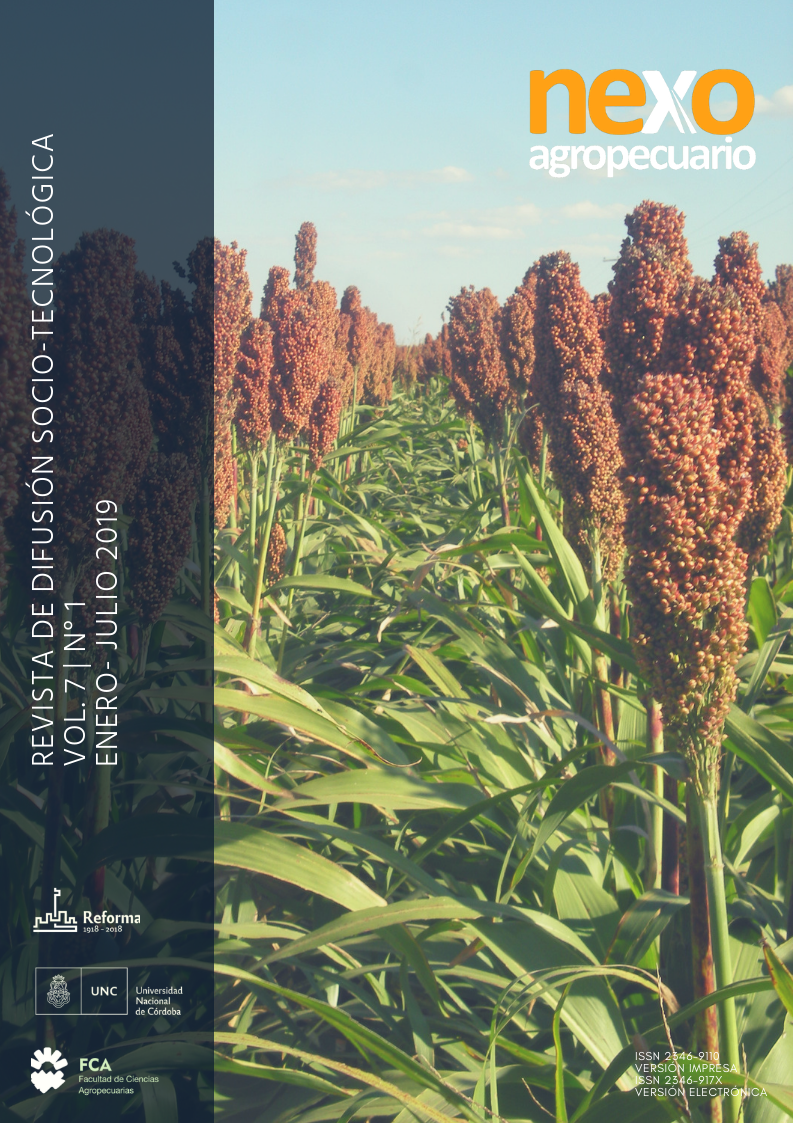Elaboration of amendments and substrates for productive and didactic purposes in an urban vegetable waste composting plant in the UNC
Keywords:
Compost, composting, substrate, amendment, organic fertilizerAbstract
In the University City of Cordoba, Argentina, organic waste is recycled from the maintenance of green areas from 2012, and canteens from 2015. The first ones (Chip) are chopped and stowed during several months. Organic waste (Vegetables) is mixed with Chip, in a ratio of 1:2 v/v, and composted. This recycling reduces economic and environmental costs, generates valuable products and serves as didactic material for students of Gardening and Floriculture of the FCA-UNC. The chemical, physical and maturity characterization of the two products obtained shows that a product of good agronomic quality is obtained, but for different uses. Both have low salt content and alkaline pH. The physical characteristics are similar, except for the granulometry, which is finer in compost. According to the data obtained the compost (Chip + Vegetables) is considered suitable for substrate. The Chip could only be used in more diluted proportions, as an amendment. Actions to improve efficiency are suggested.
References
Abad M, Noguera P, Burés S. 2001. National inventory of organic wastes for use as growing media for ornamental potted plant production: case study in Spain. Bioresour Technol, 77(2): 197-200.
Ansorena Miner, J 1994. Sustratos: Propiedades y Caracterización. Ediciones Mundi Prensa. Madrid. 172 pp.
Barbaro LA, Karlaninan MA. 2012. Uso del compost en la formulación de sustratos para plantas. En: MJ Mazzarino & P Satti (eds.). Compostaje en Argentina: Experiencias de Producción, Calidad y Uso. Pp.175-184. UNRN y Orientación Gráfica Editora. Buenos Aires.
Campitelli PA 2010. Calidad de Compost y Vermicompuestos para su uso cono Enmiendas Orgánicas en Suelos Agrícolas. Tesis, Escuela para Graduados, Facultad de Ciencias Agropecuarias, U.N.C.
Cooperband L. 2000. Sustainable use of by-products in land management. In: Bartels, J.M., Dick,
W.A. (Eds.), Land Application of Agricultural, Industrial, and Municipal By-products. SSSA Book Series Nº 6, Madison, USA, pp. 215–235.
Di Rienzo J, Casanoves F, González L, Tablada M, Robledo C, Balzarini M. 2007. Infostat. Versión 2007. Grupo InfoStat. FCA, UNC, Córdoba, Argentina.
García C, Hernández T, Costa F. 1991. Study on water extract of sewadge sludge composts. Soil Sci.Plant Nutr. 37: 399-408.
Municipalidad de Córdoba, 2019. Higiene Urbana. https://www.cordoba.gob.ar/servicios/ vecino/higiene-urbana/.
Hubbe, MA, Nazhad M, Sanchez C. 2010. Composting as a way to convert cellulosic biomass and organic waste into high-value soil amendments: A review. BioResources 5(4): 2808-2854.
Kowaljow, E, Mazzarino MJ, Satti P,Rodriguez CJ. 2010. Organic and inorganic fertilizer effects on a degraded Patagonian rangeland. Plant Soil 332: 135–145.
Mazzarino, MJ, Satti P. 2012. Indicadores de estabilidad, madurez y calidad de compost. En: M.J. Mazzarino y P. Satti eds.). Compostaje en la Argentina. Experiencias en producción, calidad y uso. Editorial UNRN - Orientación Gráfica Editora. p 13-28.
Laos, F, Mazzarino MJ, Walter I, Roselli L, Satti P, Moyano S. 2002. Composting of fish offal and biosolids in NW Patagonia. BioresourceTechnol. 81: 179-186.
Lavado, R. 2012. Origen del compost, proceso de compostaje y potencialidad de uso. En: MJ Mazzarino & P Satti (eds.). Compostaje en Argentina: Experiencias de Producción, Calidad y Uso. Pp.3-12. UNRN y Orientación Gráfica Editora. Buenos Aires.
Leconte, MC, Mazzarino MJ, Satti P, Iglesias MC, Laos F. 2009. Composting poultry manure with rice hulls and/or sawdust in NE Argentina. Waste Manage. 29: 2446-2453.
Moreno, J, Moral R, García-Morales JL, Pascual JA, Bernal MP (Eds). 2015. Uso del compost como componente de sustratos para cultivo en contenedor. Ed Mundi Prensa, Madrid, España.
Ravid, M, Ylieth JH. 2008. Soiless culture: theory and practice. Ed. Elsevier 587 pp.
US Compost Council. 2001. The Test Method for the Examination of Composting and Compost (TMECC). https://compostingcouncil.org/tmecc/. SCyMA y SENASA, 2019. Marco Normativo para la Producción, Registro y Aplicación de Compost. Secretaría de Control y Monitoreo Ambiental y Servicio de Sanidad y Calidad Agroalimentaria, Resolución conjunta 1/2019.https://www.argentina.gob.ar/normativa/ nacional/resoluci %C3%B3n-1-2019-318692/texto.
Tognetti, C, Mazzarino MJ, Laos F. 2008. Compost of municipal organic waste: effects of different mana¬gement practices on degradability and nutrient release capacity. Soil Biol. Biochem. 40: 2290–2296.
USEPA, 1995. Test methods for evaluating solid waste. Vol IA: Laboratory manual physical/chemical methods. SW 846, 3rd Ed. U.S. Gov. Print. Office, Washington D.C.
Zubillaga, MS,Lavado RS. 2006. Phytotoxicity of biosolids compost of different maturity degree compared with biosolids and animal manures. Compost Science and Utilization 14: 267-270.
Zucconi, F, Pera A, Forte M, De Bertoldi M. 1981. Evaluating toxicity of immature compost. BioCycle 22: 54-57.
Downloads
Published
Issue
Section
License
Copyright (c) 2019 A. Ringuelet, A. del C. Rollán, J. Koritschoner, V. Blarduni, L. Vargas

This work is licensed under a Creative Commons Attribution-NonCommercial-ShareAlike 4.0 International License.
Attribution - Non-Commercial - Share Alike (by-nc-sa): No commercial use of the original work or any derivative works is permitted, distribution of which must be under a license equal to that governing the original work.


